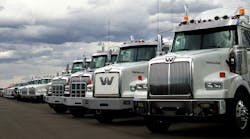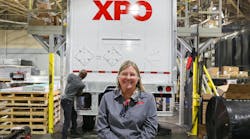Savings are really adding up for Amtrak since it centralized control of all vehicle functions. The proof is in the numbers: Between 2000 and 2004, the operating budget for all vehicle accounts dropped $9 million.
Bob Jones, director of fleet management, says, “Everything that happens, from vehicle spec'ing and procurement to vehicle disposal, now all comes out of Bear, DE, so we have better control and can follow the progress of each vehicle from cradle to grave.”
Much of the progress Amtrak has made in cutting vehicle operating costs is the direct result of a major restructuring of the Automotive Group that occurred in 2002 when David Gunn became the new company president. Charged with the task of setting up improved business controls to save money, the Automotive Group revised its policies and procedures, including developing strict guidelines for vehicle standards and procurement.
The Amtrak field service fleet currently stands at 1,933 vehicles, and is comprised of everything from Class 1 to Class 8 trucks. Because it is partially funded by the government, Jones says Amtrak is able to lease GSA (General Services Administration) vehicles. “In addition to 1,449 GSA vehicles,” he reports, “we own 370 of our own vehicles, and we manage another 114 for our commuter agencies on the West Coast.”
In the Northeast corridor — from Boston to Washington DC — Amtrak owns and operates its own trains and is responsible for maintaining the infrastructure, which means this part of the country has the biggest concentration of the company's field service vehicles, at 75-80%
Jones compares Amtrak's service fleet operations to that of a large utility. “Our workers use the trucks in the field in a number of different job functions, including repairing and maintaining the catenary system from the ground up, maintaining the railroad switches, maintaining and repairing bridges, and installing the track.”
Donald Lubinsky, automotive manager-maintenance, says: “There is a standard truck for each job function on the railroad. For unique situations, such as track inspection and for getting trucks to job sites not accessible along the railroad track, we will also spec a High Rail. These are rail wheels attached to the front and rear of the vehicle that are hydraulically operated and enable the truck to be driven on the track itself.”
Lubinsky notes that maintenance on the vehicles is done either in Amtrak's maintenance facility in Philadelphia, where a lot of the vehicles are stationed, or by an Amtrak-authorized outside vendor. “Prior to last September, when we moved to centralized maintenance, drivers decided where to take their trucks for service in the field. Consequently, it was hard to maintain a good record of what was performed on each vehicle and where it was done.”
Things have improved dramatically since Amtrak established a Central Maintenance Control Center and began using Chevin Fleet Solutions' RoadBASE software to manage everything from work orders and scheduled PMs, to maintaining vehicle histories, keeping track of due dates for various regulatory requirements on different types of trucks, and streamlining the billing processes, Lubinsky reports.
“The RoadBASE system is helping us improve cost control and warranty recovery as well,” says Lubinsky. “All calls from drivers now come into the Center, which is staffed with people highly knowledgeable about maintenance and who can talk to outside vendors about repairs to make sure they are really necessary and that we are getting the best price possible.”
Bob Jones sums it up when he says the biggest benefit of centralized maintenance control is that it has alleviated Amtrak's field employees from vehicle responsibilities so they can focus on their primary mission: keeping the railroad running safely.


